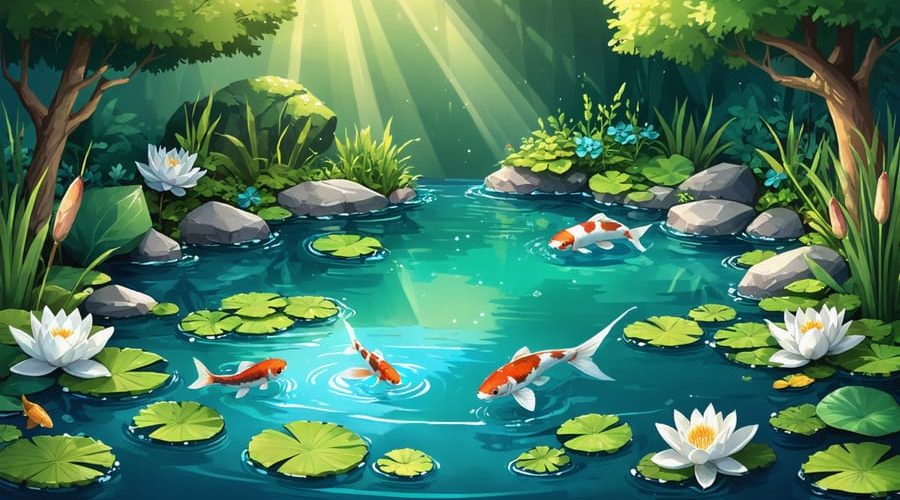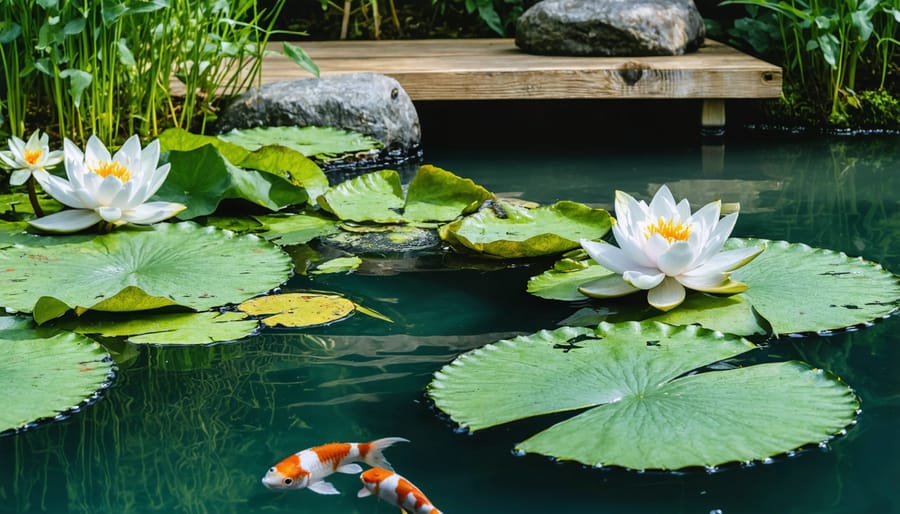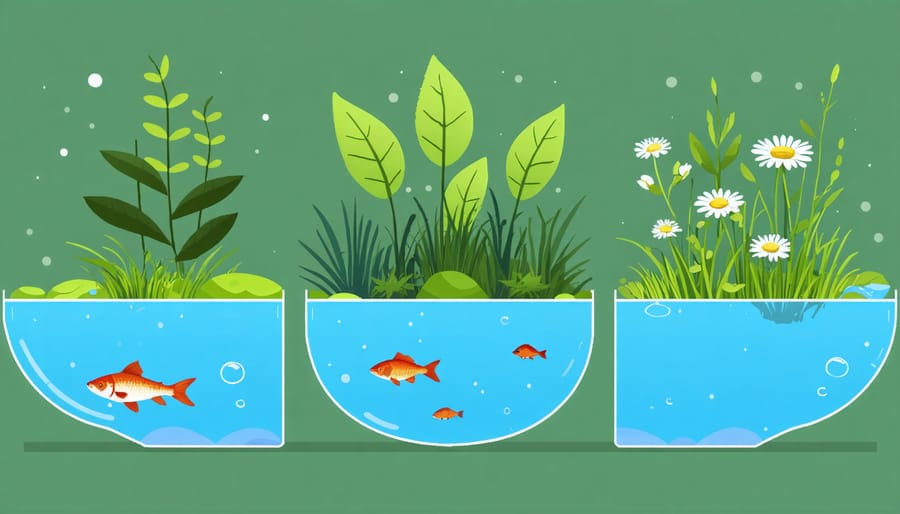
Perfect Pond Balance: How Nature’s Systems Keep Your Water Garden Thriving
Picture a delicate balancing act where every creature, from the tiniest microorganism to the largest predator, plays a vital role in maintaining nature’s harmony. Ecosystem balance isn’t just a scientific concept—it’s the intricate dance that keeps our planet’s environments thriving and resilient. When this balance is disrupted, whether through human activity or natural events, the effects ripple through entire communities of living things, often with far-reaching consequences.
In healthy ecosystems, producers like plants convert sunlight into energy, herbivores keep plant populations in check, and predators regulate herbivore numbers—all while decomposers recycle nutrients back into the system. This perfect choreography ensures resources are used efficiently, waste is minimized, and populations remain stable. Yet this balance is increasingly threatened by climate change, habitat destruction, and the introduction of invasive species.
Understanding ecosystem balance isn’t just academic—it’s crucial for anyone interested in conservation, gardening, or simply being a responsible steward of our environment. Whether you’re managing a backyard pond, maintaining a garden, or making choices about resource consumption, recognizing how your actions impact nature’s equilibrium is the first step toward protecting these vital systems for future generations.

The Three Pillars of Pond Ecosystem Balance

Plants: Your Pond’s Natural Filters
Plants are the unsung heroes of your pond’s ecosystem, working tirelessly as natural filters while adding beauty to your water garden. They play three crucial roles: absorbing excess nutrients, providing oxygen, and creating natural shelter for pond life.
Submerged plants, often called oxygenators, work beneath the surface to remove nutrients that algae would otherwise feed on. These underwater warriors, like Anacharis and Hornwort, release oxygen during the day, helping maintain healthy water conditions for fish and beneficial bacteria.
Floating plants, such as Water Lilies and Water Hyacinths, shade your pond and reduce algae growth by blocking excessive sunlight. Their leaves also provide essential cover for fish, while their roots absorb nitrates and other nutrients from the water.
Marginal plants, growing along the pond’s edges, act as natural filters by trapping debris and absorbing nutrients through their roots. Plants like Iris, Rush, and Cattails not only create a stunning transition between water and land but also provide vital biological filtration.
For the best results, aim to cover about 60% of your pond’s surface with a mix of these plant types. Start with a few varieties and gradually add more as you observe how they adapt to your pond’s conditions. Remember that different plants thrive in different depths, so create varying levels in your pond to accommodate a diverse plant community.
When selecting plants, consider your local climate and pond size. Native species often perform best and pose no risk of becoming invasive. With the right balance of plants, your pond will develop a self-sustaining ecosystem that requires minimal maintenance while providing maximum enjoyment.
Fish: The Living Elements
Fish are the heartbeat of your pond’s ecosystem, playing multiple vital roles that go far beyond their ornamental beauty. Think of them as living water filters, constantly helping to maintain water quality as they swim and feed. But like any good thing, balance is key when it comes to stocking your pond with fish.
For most garden ponds, the general rule of thumb is to allow 1 inch of fish per 10 gallons of water. This might seem conservative, but it’s crucial for maintaining healthy oxygen levels and preventing waste buildup. Remember, those tiny koi or goldfish you introduce today will grow significantly over time!
Different fish species contribute uniquely to your pond’s ecosystem. Bottom feeders like catfish help clean up debris, while surface feeders like koi and goldfish control insect populations. Some fish even help manage aquatic plant growth by feeding on algae. However, overstocking can quickly lead to problems: reduced oxygen levels, increased waste, and stressed fish that are more susceptible to disease.
When planning your fish population, consider:
– The pond’s size and depth
– Available filtration
– Plant coverage
– Local climate
– Other aquatic life present
Start with a smaller number of fish and observe how your pond handles the bioload. It’s easier to add more fish later than to deal with the consequences of overcrowding. Watch for signs of stress like fish gasping at the surface or lethargy, which might indicate it’s time to reduce your fish population or upgrade your filtration system.
Beneficial Bacteria: The Invisible Workers
Think of beneficial bacteria as your pond’s invisible cleaning crew, working tirelessly to maintain crystal-clear water and a thriving ecosystem. These microscopic heroes break down organic waste, fallen leaves, fish waste, and excess nutrients that would otherwise cloud your water and potentially harm your aquatic friends.
Just like a well-oiled machine, beneficial bacteria operate in different teams. Some specialize in converting harmful ammonia (from fish waste) into less toxic nitrites, while others transform these nitrites into safer nitrates that plants can use as food. This process, known as the nitrogen cycle, is essential for keeping your pond water healthy and balanced.
To help these helpful microorganisms thrive, they need three key elements: oxygen, surface area to colonize, and the right temperature. Natural pond aeration provides the oxygen they need, while filter media, rocks, and plants offer plenty of surface area for bacteria to call home.
During warmer months, these bacteria are at their most active, processing waste more efficiently. In colder weather, their activity slows down, which is why it’s important to reduce feeding and maintain good circulation year-round. Adding beneficial bacteria supplements, especially after cleaning filters or treating the pond with medications, can help maintain a strong bacterial colony.
Remember, a healthy bacterial population is like having an invisible maintenance crew that never takes a day off. By supporting these helpful microorganisms, you’re investing in your pond’s long-term health and clarity, making your water garden more enjoyable with less manual maintenance required.
Signs of an Unbalanced Pond Ecosystem
A balanced pond ecosystem maintains itself naturally, but when things go wrong, your pond will send clear distress signals. One of the most common signs of imbalance is excessive algae growth, which can turn your water green or create unsightly blankets of string algae. While some algae is normal, too much indicates excess nutrients and an inability to control algae naturally.
Watch out for sudden changes in water clarity. If your previously clear pond becomes cloudy or takes on an unusual color, it’s often a sign that something’s off balance. This could be due to an overabundance of fish waste, decaying plant matter, or insufficient beneficial bacteria.
Pay attention to your fish’s behavior too. If they’re gasping at the surface, appearing lethargic, or showing reduced appetite, your pond might have low oxygen levels or poor water quality. Healthy fish are active and eager to feed.
Dead or dying plants are another red flag. While some plant loss is normal, especially during seasonal changes, widespread plant problems often indicate improper nutrient levels or poor water conditions. Healthy plants should show steady growth and vibrant colors.
Foul odors shouldn’t be ignored either. A balanced pond has a fresh, earthy smell. If you notice unpleasant or swampy odors, it usually means there’s too much organic waste decomposing in your pond.
Keep an eye on your pond’s wildlife population. An overabundance of mosquito larvae or sudden disappearance of beneficial insects might indicate that your pond’s natural predator-prey relationships are out of balance. A healthy pond supports a diverse but controlled population of creatures.
Regular observation of these signs helps you catch problems early. Remember, most issues start small but can quickly escalate if left unchecked. The key is to recognize these warning signs and take action before they develop into major problems.

Practical Steps to Achieve and Maintain Balance
Creating a balanced ecosystem in your pond isn’t rocket science, but it does require consistent attention and the right approach. Start by ensuring you have adequate filtration – both mechanical and biological – to handle your pond’s size and fish load. A good rule of thumb is to filter your entire pond volume at least once every two hours.
Next, focus on establishing a diverse plant population. Aim for a mix of submerged, floating, and marginal plants, covering about 60% of your pond’s surface. Water lilies and hornwort are excellent choices for beginners, while marsh marigolds add beautiful color to pond edges.
Regular maintenance is crucial. Develop a weekly routine to remove debris, check equipment, and maintain proper water chemistry. Test your water parameters at least once a week, paying special attention to ammonia, nitrite, and pH levels.
Don’t overstock your pond with fish – a common beginner mistake. The general guideline is one inch of fish per ten gallons of water. Remember to introduce new elements gradually, allowing your ecosystem time to adjust.
Consider adding beneficial bacteria monthly to help break down organic waste and maintain clear water. During spring and fall, perform partial water changes of about 10-15% to refresh the system.
Lastly, create zones of different depths in your pond. This provides various habitats for different species and helps maintain stable water temperatures. Deep areas (at least 3 feet) give fish a safe space during extreme weather, while shallow shelves are perfect for marginal plants.
Seasonal Considerations for Ecosystem Management
Just like your garden, your pond’s ecosystem needs different care throughout the year. Spring is the time for gentle system startup, gradually increasing feeding as temperatures rise, and adding beneficial bacteria to jumpstart the biological cycle. In summer, focus on maintaining proper aeration and managing algae growth while keeping up with regular filter maintenance.
Fall requires preparation for the colder months ahead, including removing fallen leaves and gradually reducing fish feeding as temperatures drop. When it comes to winter pond maintenance, protect your system from freezing by installing de-icers if needed, and avoid breaking surface ice as this can stress fish.
For best results, test water parameters more frequently during seasonal transitions, as these are times when your pond’s ecosystem is most vulnerable to imbalances. Keep a seasonal maintenance calendar to track tasks and remember that gradual changes are always better than sudden ones when adjusting your pond care routine throughout the year.
Creating and maintaining a balanced ecosystem in your pond is a rewarding journey that benefits both aquatic life and your enjoyment of the water garden. By implementing proper filtration, choosing the right mix of plants, and maintaining appropriate fish populations, you’ll create a thriving aquatic environment. Remember, small changes made consistently can have a big impact. Start applying these principles today, and watch your pond transform into a self-sustaining paradise that brings joy for years to come.
